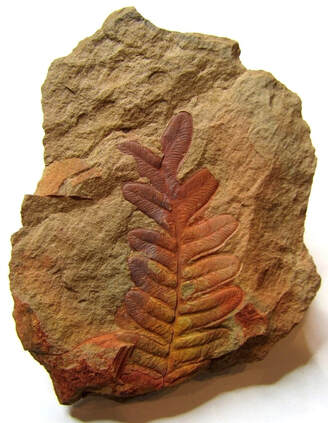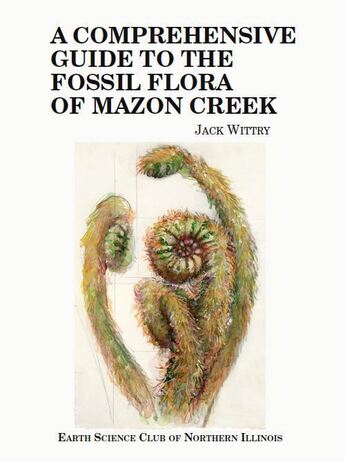News
New ExhibitionHuman / Nature
The Weight of Our Actions on the Natural World Douglas Stapleton, curator
Illinois State Museum Human | Nature brings together artists who address our relationship to the natural world as the source of our sustenance. How do we see that relationship? Do we think of resources as endless and only for our benefit? Do we see ourselves connected with the natural world or separate from it? These artworks look at our perceptions and beliefs about this relationship, and the consequences of our actions.
|
Nature provides us with life, the air we breathe, and the water we drink. It is also the food we gather or grow and the materials we harvest for shelter, clothes, and tools. Humans see nature as a resource, something we use for a purpose. In our modern, industrial world, we think of resources as something to extract, remove and exploit, actions that move in one direction towards us...
Continuing ProjectHerrin Fossil Flora Survey
In 2021, the Earth Science Club of Illinois (ESCONI) was granted collecting access to an early 20th century shaft mine spoil near Danville, IL, and has since made several field trips to the private property. The Herrin Coal that was mined there is slightly younger than the Colchester #2 seam which lies beneath the now famous Mazon Creek fossil concretion beds to the north. Though “only” about 1.5 million years in difference (a blink of an eye when we’re talking Geologic Time), the fossil plants do show variation and, at present, very little study has been made about the diversity of the Herrin Flora assemblage.
|
What makes this site remarkable is that carbon impressions in soft shale – not the fossils that exist in protective siderite “cocoons” – have been cooked by a natural bisque-firing within the spoil pile, to the point of looking and feeling brick-like. Fragile and exquisite forms that would ordinarily be lost when exposed to the elements are now preserved, at least long enough for a collector to find. The club has endeavored to document what is being found at the site and, with the help of Jack Wittry of Chicago’s Field Museum, we’ve begun to archive the finds as a foundation for what could be a future paper and comprehensive catalog on the subject. I have selected some of the best examples for a fossil image gallery that both compliments our club’s developing field guides and furthers the conversation about the evolution of plant forms in Illinois.
Continuing ProjectMazon Creek Fossils
Since 2005, I’ve been enamored – some might say, obsessed - with the geology of northern Illinois and the fossils born
of it. Field collecting and research not only fulfill a lifelong interest in the natural world, but the aesthetics of the beautifully preserved plants and animals, as well their connection to a time span almost incomprehensible to us new arrivals on the planet, lend subject matter for my art. In 2008, Douglas Stapleton, curator at the Illinois State Museum, had the intuition to exhibit my paintings along with examples of Mazon Creek fossils from the museum collections before he even knew of my passion. |
The physical material of the specimens at times becomes pigments for painting, attaching the chemistry of the object to time and to place. And the miraculous story of evolution (as well as that of human industry) pushes
my small artistic statements toward something larger.
my small artistic statements toward something larger.
Over the years, I’ve taken thousands of photographs of Mazon Creek fossils, curated collections at museums, and collaborated in the creation of books on the subject. I feel now that it’s incumbent on me to share the wealth, as
it were, organizing the images, and listing the collection, catalog number, and locality from where the specimens came whenever possible.
it were, organizing the images, and listing the collection, catalog number, and locality from where the specimens came whenever possible.
New ExhibitionFor over three decades, Andrew Young has created art that presents nature as a reference point for human aspirations, worldly and spiritual. His earlier tempera works grappled with our natural desire for ethereal and transcendent experience, yet constrained by such temporal matters as history and mortality. The next phase in Young’s work more clearly reflected his background in science. Carefully constructed collages explored how we observe and catalog our surroundings, defining us through the models and language we use. A new direction here goes further into the physical aspect of art making; specific sources of pigments, their collection and processing, carry as much meaning as any imagery found or invented. The material itself grounds us to a living or geological occurrence, and to a place.
|
Today, we are at an inflection point in our relationship to the landscape. No matter if one’s perception of nature is romantic, aesthetic, or purely utilitarian, dramatic change is underway. All This Land is a paradoxical title for a show that uses a little humor, theater, abstraction, and a ton of recovered objects to address a more somber awareness that the Earth’s fragile systems and resources, despite some current beliefs and tendencies, are not inexhaustible.
New Essay(excerpt)
The subject matter in my work has always had something to do with our relationship to the natural world. Nature itself is breathtaking and mysterious, and deserves to be glorified, but with my art I’ve become much more interested in the distance between us and our surroundings, and the way we interpret or manipulate nature to conform to what we think of as “natural.” If the application of raw mineral pigments in my early egg temperas was to revisit and somewhat abuse the techniques of Renaissance Masters for the purpose of showing a human emotional space between higher spiritual aspirations and our earthly mortal selves, then the underpinning of the collages would be a striving to address the language of natural history: the way we classify nature and what is says about us.
|
The more I thought about the landscape, the more elusive nature seemed to me. Along with a more singular focus on collage-then-mixed media studio work came a coincident practice of collecting fossils, stones, ores, and natural pigments from field trips all over the state and country. Just as the material ingredient in Antonio Burri’s 1950s work rose in presence and meaning equivalent to anything pictorial, I was literally bringing nature as I found her into my practice and, in turn, the notion of “place” became a new arena for content.
New Book ProjectThe Earth Science Club of Northern Illinois is pleased to announce the publication its latest Mazon Creek fossil book entitled, A Comprehensive Guide to the Fossil Flora of Mazon Creek. Since the 2006 release of Jack Wittry’s first book, The Mazon Creek Fossil Flora, much work has been done in the field and many new taxa have been discovered, some rare and unique to the area. Over 20,000 specimens were identified and studied from three different institutions for this project alone. In addition to updated names and natural affinities based on the most current scientific literature, this volume contains over 120 more pages of information, with detailed color photos and a broad census extracted from The Field Museum’s collection. Pages in this edition are also reorganized from the most archaic to the most derived plant groups to conform to other contemporary taxonomic works. The Mazon Creek flora of Illinois is still the most diverse known flora of Paleozoic age in North America.
|
This magnificent book integrates all of the latest research and helps to further our understanding of plant evolution, perhaps paving the way for more incredible discoveries. There is a limited printing of this 288-page volume, in both hard and soft covers. The book will be available starting February 2020 through the club - esconi.org
Project UpdateThe Fall of Cities in the Mediterranean
book cover (excerpt)
For the purpose of the book cover project, I asked Professor Sutor to send me an archaeological plan of Troy, not just for the 5,000 years of history it represented, but for its abstraction in form: the familiar boxes, curves, and repeating lines of age-old structures like temples, theaters, and fortifications. I decided to digitally rid the map of its grid spacing and any notations, and let the scar of the ruins be the foundation for a painting. Since the book was about communal grief and commemoration for large-scale loss, I thought to integrate something of nature (which itself has cycles of life and death) with the architectural skeleton – something floral, perhaps with a suggestion of ritual or the funerary. It was done in mixed media, primarily of hand-ground watercolor and gouache paints made from ores. And, as with archaeology, the built up surface was scraped back, as if to hint at time, layering, concealment, and reveal. The resulting artwork was accepted and appeared on the cover when the book was published in 2016, a full eight years after my initial meeting with its authors.
|
New ExhibitionKate Pollasch, curator
The University Club of Chicago is pleased to present artist Andrew Young in a solo exhibition of collage and mixed media works that exhume the mysterious beauty of the natural world. Like a cabinet of curiosities, Young’s two-dimensional works combine fractured and abraded materials into a textured surface of earthly elements. A lifelong collector and explorer, Young’s practice balances discovering and classifying the known world with visualizing the illusory pull of the unknown. This exhibition showcases a survey of work across the artist’s collage repertoire, offering a rare opportunity to review over a decade of artistic expression. Attend opening night in the gallery where you can meet the artist and learn more about his artwork.
|
New Photo PagePhotography has always been a private companion to my formal and more public practice of painting and collage. As nature has been a primary subject for my work and continues to play a role in its message, I am constantly looking to the land for inspiration. I document what I see and feel around me – the subtle dynamism of the environment, including moments of changing, low-angled light and water in all its states: reflection, translucency, movement, and abstraction. A critic of my earlier tempera panels once described their effect as “transience captured.” This is a gallery of images from the Illinois landscape that seeks a similar fleeting quality. In their stillness and modesty of color and scale, I would call them “sketches,” but no less important to the larger project.
|
Recent Museum Acquisitions
|
Understood by Weather, 1992
egg tempera on wood panel 46 x 32.5 inches |
|
Enter the Marsh, 1996-97
egg tempera on wood panel 44 x 32 inches |
|
Tigress, 1991
egg tempera on wood panel 23 x 22.5 inches (diptych) |
© The above images may be protected by copyright. They are posted on this site in accordance with
fair use principles, and are only being used for informational and educational purposes.
fair use principles, and are only being used for informational and educational purposes.
|
Copyright © 2020 Andrew Young. All rights reserved.
|












